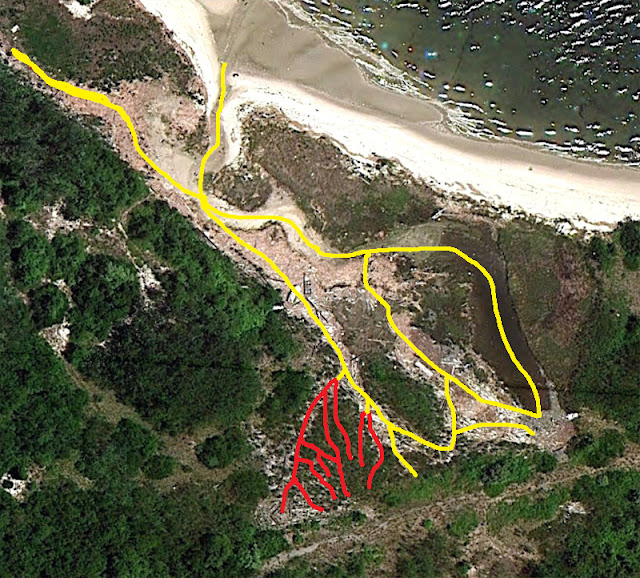During takeoff one managed to dislodge the Styrafoam wedges holding my camera trap in place. A more stable mounting system is now being employed.
Skimmers sliced across the marsh throughout the day, sometimes three at a time. I'd seen many feeding on the bay side of Breezy Point, usually at dusk. Years ago, while fishing there, I unintentionally clotheslined one (it quickly returned to its activities unscathed). Today was the second time I'd seen them use the marsh, where plenty of killifish are to be had at low water.
The main channel is narrow, about twenty feet across. That's not much of a runway for a bird that flies with half its face in the water. But today I observed an incredibly acrobatic strategy for getting the most out of the little marsh. Instead of making one long pass lengthwise, the skimmers made multiple dips on an S-shaped sweep, dipping in for just a few seconds before banking hard to come around for another dip. They caught fish on nearly every attempt this way. Because I watched this from the opposite side of the marsh, without a camera, this crude recreation will have to do...
Least terns were present as well, but the green herons were especially bold today. Perhaps that's because of the willets. They've been less aggressive toward me and everything else. I'd seen them chase away the green herons so many times that I was astounded to see this chummery.
On to cleanup. As the main stems of the marsh are gradually cleared of debris (indicated yellow) we turn our attention to the smaller channels (indicated red), which sit on mounds of debris above the high-water mark. This means water rarely penetrates a significant portion of the marsh.
One way to promote tidal flooding is to gradually deepen these channels by shovel. Researchers Juan Gallego Fernandez and Francisco Garcia Novo found that after opening channels to create a ditch network on a marsh restoration in Spain, fish immediately colonized the new water paths 1. This technique is employed widely, and notably in the case of the Hackensack Meadowlands, where the creation of more channels improved water quality by creating greater water surface for oxygen exchange and increasing tidal flushing 2. Sarah and I have begun prepping the smaller channels by clearing them of wood and debris in hopes that we can deepen them in the future.
One way to promote tidal flooding is to gradually deepen these channels by shovel. Researchers Juan Gallego Fernandez and Francisco Garcia Novo found that after opening channels to create a ditch network on a marsh restoration in Spain, fish immediately colonized the new water paths 1. This technique is employed widely, and notably in the case of the Hackensack Meadowlands, where the creation of more channels improved water quality by creating greater water surface for oxygen exchange and increasing tidal flushing 2. Sarah and I have begun prepping the smaller channels by clearing them of wood and debris in hopes that we can deepen them in the future.
High of 83, max humidity 91%, average wind ( ) @ 2 MPH, 5.6 high tide @ 06:30 PM. Moon 12% visible.
Water level recorded at 4 inch mark.
Birds seen in marsh: red winged blackbird, willet, common tern, least tern, skimmer, osprey, cedar waxwing
Birds seen in bay: laughing gull, herring gull, willet, mallard
References:
1. Weis, Judish S. and Carol A. Butler. Salt Marshes: A Natural and Unnatural History. Rutgers University Press, New Brunswick, 2009. P. 178
2. Ibid, p. 208
Birds seen in bay: laughing gull, herring gull, willet, mallard
References:
1. Weis, Judish S. and Carol A. Butler. Salt Marshes: A Natural and Unnatural History. Rutgers University Press, New Brunswick, 2009. P. 178
2. Ibid, p. 208






































